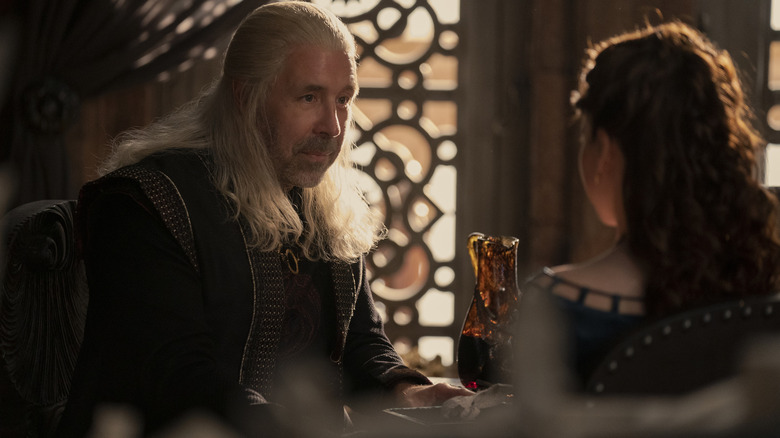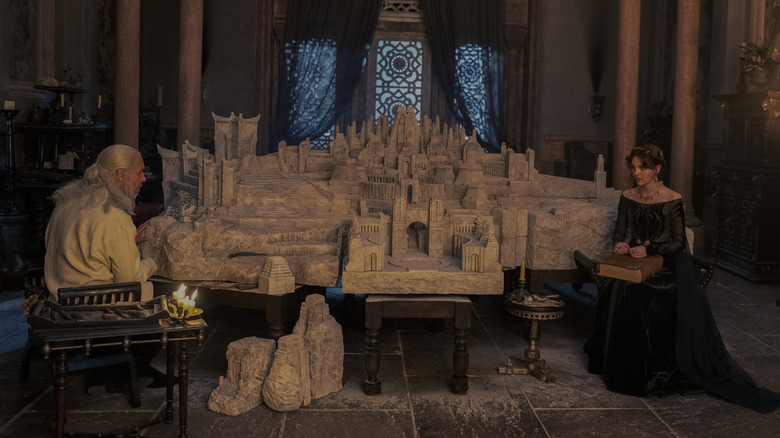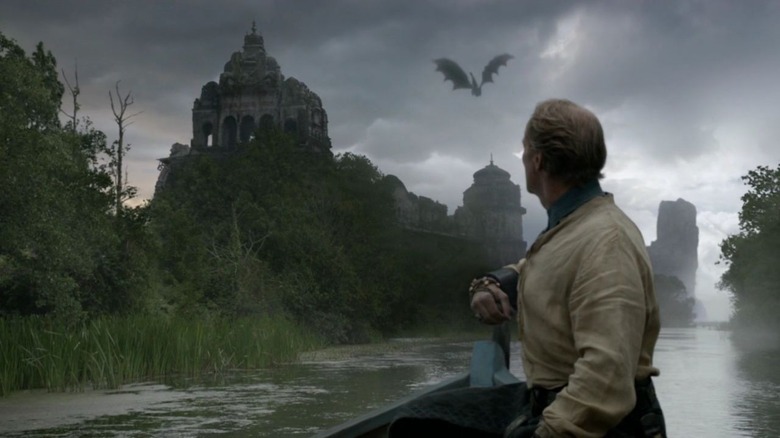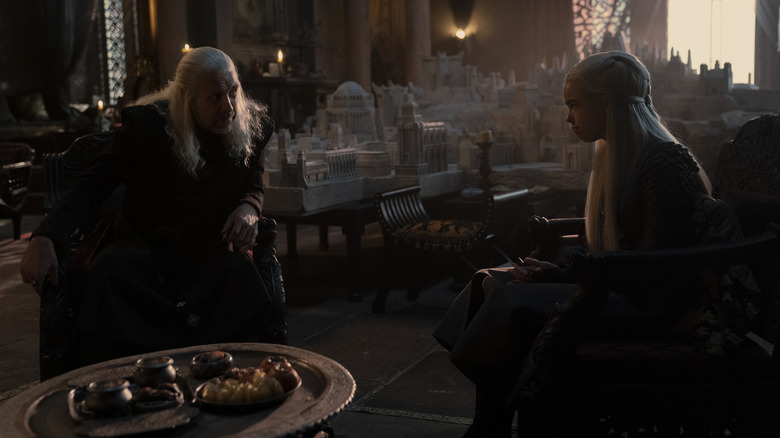House Of The Dragon: The Significance Of Old Valyria Explained
No fantasy series can truly thrive without the help of persuasive, fully-formed world building, and "House of the Dragon" is no exception. Whether it's the byzantine assassin underworld filled with honor and rules in "John Wick," the incredibly specific yet wonderfully malleable atmosphere and tone of "Star Wars," or the millennia of prior events influencing Middle-earth in "The Lord of the Rings," audiences wholeheartedly bought into these various universes, in no small part due to the well-worn idea that these stories and settings existed before their respective movies even began and last long after we received (or will receive) our final glimpse of them.
With HBO looking for a new flagship series to fill the vacuum left by "Game of Thrones," perhaps it was only fitting that its prequel series come next in the line of succession. After the premiere became a ratings bonanza and almost singlehandedly led to the show's second season renewal, the last episode doubled down on the pervasive sense of history and legacy that our new batch of characters are struggling to live up to. The mythical and long-lost might of Old Valyria is referenced time and time again, providing a stark contrast to the waning Seven Kingdoms of Westeros — and none feel this weight more than King Viserys (Paddy Considine), brooding in his private room over a stone-chiseled recreation of Valyria.
But what exactly was this ancient realm and what's the significance behind it, spoken of by characters in both "Game of Thrones" and "House of the Dragon" in hushed tones and with an air of mystery? Well, you've come to the right place.
What is Valyria?
Rarely has the phrase, "Those who don't learn from history are doomed to repeat it" felt more ominous than when describing the world of "Game of Thrones," providing yet another connection between the parent series and "House of the Dragon." The history of Westeros and its accompanying continent in the east — called, believe it or not, Essos — looms large in the minds of the Targaryen royal family at the center of the prequel series, particularly because of all it represents for their ancestry. But even the most casual viewers likely perked up their ears upon hearing Viserys talk to young Alicent Hightower (Emily Carey) about the glories of Old Valyria.
Given how much both the original series and "House of the Dragon" allude to that mystical locale, it's important to know that Old Valyria is the name for the city that once served as the capital of an ancient civilization of dragonriders known as the Valyrian Freehold, of whom House Targaryen was only a minor offshoot (along with House Velaryon, represented by the "Sea Snake" Corlys played by Steve Toussaint).
For over 5,000 years, Valyria was essentially the center of the world, capable of the grandest feats and technological advancements anyone had ever seen. In his novel "Fire & Blood," which "House of the Dragon" is based on, author George R.R. Martin describes the plight of dozens of rival houses all jockeying for power in their own game of thrones ... until the event known only as The Doom, a largely unexplained catastrophe taking place another few hundred years before the events of "House of the Dragon," likely involving the eruption of 14 volcanoes ringing the kingdom and commonly thought to have been brought on by the Valyrian propensity to dabble in the black arts.
Where have we heard this before...?
When the fabled kingdom of Valyria underwent its swift and total destruction, obviously cribbed from our own mythological legends of Atlantis and borrowed loosely from the fall of the Roman Empire itself, only House Targaryen and Velaryon escaped the carnage — the former by an ancestor's premonition of the event over a decade before it actually happened, the latter by their ambition to branch out and explore the world.
If the general idea of this backstory sounds vaguely familiar to those who watched "Game of Thrones," it should.
Early episodes of season 1 first introduced the concept of Valyria as the place Targaryens flew from in order to conquer Westeros on the backs of their dragons, with Daenerys Targaryen (Emilia Clarke) describing herself as "of the blood of Old Valyria" with a manifest destiny to rule over all others. In season 2, the mysterious Quaithe (an easily forgotten character portrayed by Laura Pradelska) explained the dangers of too sailing close to the ruins of Valyria, which has become an abandoned ruin that few ever dare go near. Main characters Tyrion Lannister (Peter Dinklage) and Jorah Mormont (Iain Glen) did just that in season 5, sailing right through the shattered remains and almost paying for it with their lives. To date, this has been our one and only glimpse of Old Valyria in live action.
The Valyrian might wasn't only defined by their dragons, however. The prestigious Valyrian steel swords common throughout Westeros, but wielded only by figures of renown (such as Sean Bean's Eddard Stark and his famed sword Ice), are the only remnants of Valyria's power. With their forging secrets lost along with the realm, none have managed to recreate such weapons or any other facet of Valyria again.
What does this mean for House of the Dragon?
So what's the big deal with this anyway and why should viewers even bother to try to keep terms like "Velaryon" and "Valyria" straight in the first place? Aside from George R.R. Martin apparently taking a sick pleasure out of torturing his readers (also see: two separate main characters named Rhaenys and Rhaenyra), the echoes of Valyria's downfall just might paint a picture of what may befall the characters of "House of the Dragon."
The series makes the intriguing choice to put Valyria front and center in the second episode, as King Viserys monologues about the Valyrian capital and several shots pointedly frame the out-of-his-depth ruler with Old Valyria just out of focus behind him, haunting his every thought and seemingly judging his every step. Just as "a thousand dragons" and a vast fleet couldn't stop The Doom from wiping the empire off the face of the map and setting House Targaryen on a collision course with Westeros, leading to the new status quo that "House of the Dragon" has inherited, the Targaryen line of succession hangs by a single thread — his daughter Rhaenyra (Milly Alcock) — that no amount of dragons at their disposal can fully protect.
The emphasis on Old Valyria serves as a cautionary tale to House Targaryen's ambition in this prequel series, as we've already seen several would-be rulers start to make their own power plays while King Viserys has no male heir to the Iron Throne, from Matt Smith's Daemon Targaryen scheming with Corlys to even Otto Hightower (Rhys Ifans) placing his daughter Alicent in such close proximity to the widower king.
Will this Targaryen family learn from their own history? If you've been paying attention, you likely already know the answer to that.



